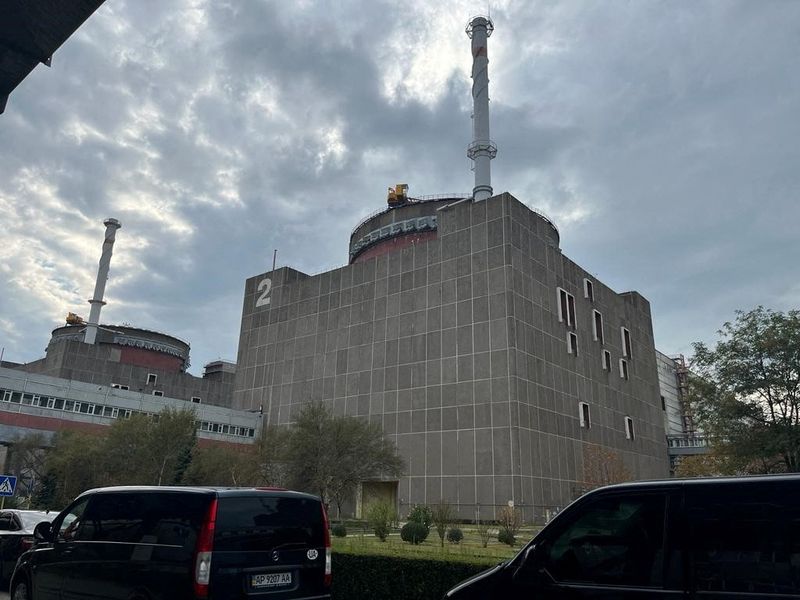Russia, West step up energy war as risk of nuclear disaster haunts Ukraine
2022.09.03 08:53
4/4

A view shows the Russian-controlled Zaporizhzhia Nuclear Power Plant during a visit by members of the International Atomic Energy Agency (IAEA) expert mission, in the course of Ukraine-Russia conflict outside Enerhodar in the Zaporizhzhia region, Ukraine,
2/4
By Tom Balmforth
ZAPORIZHZHIA, Ukraine (Reuters) – As UN inspectors sought to avert a nuclear disaster on Ukraine’s frontline, the West and Russia wounded each other’s economies, with Moscow keeping its main gas pipeline to Germany shut on Saturday while threatened with price caps on oil exports.
Russia’s state-controlled energy giant Gazprom (MCX:GAZP) blamed a technical fault in the Nord Stream 1 pipeline for the delay on Friday. But the high-level manoeuvres in energy politics were seen as an extension of the war, and the ramifications would be felt far beyond Ukraine.
The announcements came as Moscow and Kyiv traded blame over their actions at the Russian-occupied Zaporizhzhia nuclear power plant, where U.N. inspectors arrived on Thursday on a mission to help avert a catastrophe.
Vladimir Rogov, a pro-Russian official in the Zaporizhzhia region, said Ukrainian forces had shelled Europe’s largest nuclear plant several times overnight and the main power line to the station had been downed, forcing it to use reserve power sources, as occurred last week.
Reuters could not immediately substantiate his account.
Gazprom’s indefinite delay to resuming gas deliveries will deepen Europe’s problems securing fuel for winter with living costs already surging, led by energy prices.
Nord Stream 1, which runs under the Baltic Sea to supply Germany and others, had been due to resume operating after a three-day halt for maintenance on Saturday at 0100 GMT, but the pipeline operator reported zero flows hours later.
Moscow has blamed sanctions, imposed by the West after Russia’s Feb. 24 invasion of Ukraine, for hampering routine operations and maintenance of Nord Stream 1. Brussels and Washington accuse Russia of using gas as an economic weapon.
The United States said it has been collaborating with Europe to ensure sufficient supplies are available for winter.
Finance ministers from the Group of Seven wealthy democracies – Britain, Canada, France, Germany, Italy, Japan and the United States – said on Friday a cap on the price of Russian oil was meant to “reduce … Russia’s ability to fund its war of aggression whilst limiting the impact of Russia’s war on global energy prices”.
The Kremlin – which calls the conflict “a special military operation” – said it would stop selling oil to any countries that implemented the cap.
NUCLEAR FEARS
During the first six months of the war, thousands of people were killed and Ukrainian cities reduced to rubble, and now there is the danger of a nuclear calamity.
A United Nations inspection team, led by its chief Rafael Grossi, braved intense shelling to reach the Zaporizhzhia plant on Thursday.
Grossi, after returning to Ukrainian-held territory, said the physical integrity of the plant had been violated several times. On Friday he said he said he expects to produce a report early next week, and two experts from the International Atomic Energy Agency (IAEA) inspections team would stay on at the plant for the longer term.
A reactor at the site was reconnected to Ukraine’s grid on Friday, a day after it shut down due to shelling near the site, Ukraine’s state nuclear company Energoatom said.
The site sits on the south bank of a huge reservoir on the Dnipro River, 10 km (6 miles) across the water from Ukrainian positions.
Each side has accused the other of shelling near the facility, which is still operated by Ukrainian staff and supplies more than a fifth of Ukraine’s electricity in peacetime. Kyiv also accuses Russia of using it to shield its weapons, which Moscow denies. Russia has so far resisted international calls to pull troops out of the plant and demilitarise the area.
Ukraine’s state nuclear company said Russia had barred the IAEA team from the plant’s crisis centre, where Kyiv says Russian troops are stationed, and that would make it difficult to make an impartial assessment.
Ukrainian President Volodymyr Zelenskiy urged the IAEA team to go further, despite the difficulties.
“Unfortunately we haven’t heard the main thing from the IAEA, which is the call for Russia to demilitarise the station,” Zelenskiy said in a video streamed to a forum in Italy.
Russian Defence Minister Sergei Shoigu said Ukraine was continuing to use weapons from its Western allies to shell the plant. He rejected assertions by Kyiv and the West that Russia had deployed heavy weapons at the plant.
Several towns near the plant came under Russian shelling on Thursday, Zaporizhzhia regional council mayor Mykola Lukashuk said.
Rogov, the pro-Russian official, said Ukrainian forces had shelled Enerhodar, the Russia-held town near the power station. And he repeated accusations that Ukraine had mounted a commando-style raid on the station with speedboats on the river. Ukrainian officials have dismissed this as a fabrication.
Reuters could not verify either side’s reports.
COUNTEROFFENSIVE
Elsewhere on the frontlines, Ukraine started an offensive this week to recapture territory in southern Ukraine, mainly further down the Dnipro in neighbouring Kherson province.
Both sides have claimed battlefield successes in the initial days of what Ukrainians bill as a potential turning point in the war. Details have been scarce, with Ukrainian officials releasing little information.
Ukraine’s general staff on Friday said Russian forces had shelled dozens of cities and towns including Kharkiv – Ukraine’s second-largest city – in the north and in the Donetsk region in the east.








